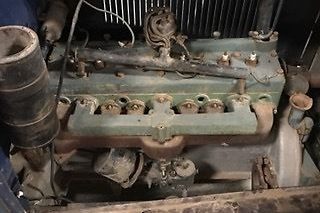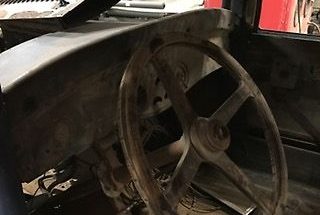Peerless Motor Company began in Cleveland, Ohio in 1900 and built cars that became known for innovation, durability, and as the name might suggest, unmatched luxury. This 1927 Peerless Six-90 “Roadster Coupe,” listed here on eBay, and located in Marshfield, Missouri, needs detailed attention if not a complete restoration. Offered elsewhere recently asking from $29,000 to $39,000, its unrestored condition, including some “wood framing rot,” limits buyers to those with the wherewithal and skills to properly refurbish this classic.
Peerless competed directly with cars like Marmon and Stutz that also offered sporty boattail coupes. This page on JRVintageAutos.com shows a lovely restored 1927 Six-90 Roadster very similar to this car. All Six-90 Coupes were boattails, a style only built from 1926 to 1929.
In 1924, Peerless began fitting this well-regarded Collins inline six cylinder engine that, according to AACA.org, featured an aluminum crankcase and made 70 HP. Peerless also offered an 8 cylinder motor also rated at 70 HP. Let’s all agree that a small-block Chevy V8 will NEVER find itself in this stylish pre-Depression coupe.
Time appears to have dealt most harshly with the interior, and only a high level of craftsmanship will restore this cabin to service. Sadly, though these pictures appear well-taken, only low-resolution copies exist on any of the sites where this car has been posted. Peerless parts are pure unobtainium; there’s no “1927 Peerless” page on RockAuto.com (though they do have some later Peerless parts). Searching, swapping, and tooling up parts should guarantee many hours of fun for the buyer. You will do a lot of back-road driving before you spot a Peerless parts car peeking out of a barn. In recent years cars in relatively original condition may receive a minimal restoration to halt deterioration and restore safe operation while preserving some natural finishes and wear. As the saying goes “They’re only original once.” What is your vision for this low-production high-class coupe?






Todd, I believe that might be a Continental engine. I’ve never heard of a “Collins,” but am familiar with Continentals as my three Kaisers had them, as did many other cars from the smaller manufacturers.
This is one of those “if I was 30 again!” cars. It looks as if it would take more time to restore than I could ever invest in it. Not sure I really like the contrast between the squarish top and the tapered tail, but I think I could live with it!
Contentinentals still built today, common in forklifts, welders, all sorts of equipment. I must have 1/2 a dozen of them. This is an interesting car, boat tail is not as elegant as on an Auburn but not bad.
Hi RayT. Perhaps, but I found several sites referencing the Collins Six which Peerless may have purchased outright at one point.
http://car-from-uk.com/sale.php?id=89136 “1927 PEERLESS Sedan Model Six-90 Collins Straight 6 Engine”
http://forums.aaca.org/topic/227006-1927-peerless-six-90-sedan-for-sale/
1927 Sedan Model Six-90 Peerless’ Collins Straight 6 Engine
However the Internet is certainly not flawless, and sometimes one mistake gets propagated all over. Can anyone else comment on which of multiple six-cylinder engines used by Peerless would be in a ’27? Thanks for challenging my research – I learn things every week from folks like you!
Todd, after years of researching stubborn little factoids like the “Collins” or “Continental” question, I learned to never make flat declarations! Someone out there will always have something to say about the subject.
I would, however, note that both your cited “Collins” engine sources come from someone called Brando Pistorius, who seems to have had a Peerless for sale.
In my case, I blame it on my years as a Kaiser owner: see a flathead six painted green, and it’s a Continental!
By 1927 Peerless was offering 2 types of motors, the 6 cylinder and the 8 cylinder. The 6 was known as the Collins motor, named after a designer at Peerless, but the 8 cylinder was indeed a Continental.
An interesting aside is what happened to Peerless at the end:
When the “dry” era ended, the building that was home to the Peerless Motor Car Company, now sat empty. In the depressed economy of the day there was little demand for the expensive Peerless product. Looking for a new business opportunity, Peerless management decided to take advantage of what they saw as the imminent rebirth of the long dormant American brewing industry.
For help in entering this new field Peerless turned to Carling of Canada, an established brewer with a long and distinguished history. In exchange for 25,000 shares of Peerless stock, Carling’s parent company provided Peerless with the rights to the formulas for Carling brews , their identifying labels, and trademarks. Technicians and brew masters were sent from Canada to convert the auto plant into a brewery and to train American personnel to operate it as the Brewing Corporation of America. The philosophy behind Carling Black Label was to have a high quality lager that was available nationwide, but with a locally brewed budget price. The strategy worked and the next several decades led to rapid growth and expansion for the brewery and the Carling Black Label brand.
The 8-cylinder engines used by Peerless in 1927 were 332 Cu. In. V-8s with an aluminum crankcase and dual exhaust, and built from 1916-1928 by Peerless, not Continental. In 1929, the most luxurious Peerless model, the 8-125, did have a Continental engine — a straight-eight of 322 Cu. In.
This blue Roadster Coupe has a Peerless 289 Cu. In. straight-six with an aluminum crankcase, sometimes called a Peerless Six, Superb Six, or Collins Six.
Engine built by Peerless. Peerless offered 4 sizes of motors in 1927: 2 by Continental & 2 by Peerless. Richard Collins was president of Cadillac, bought Peerless in 1921.
Seven years after Peerless built this car they switched products. They stopped making cars and started brewing beer. They even used the same factory and employees, just added some new equipment.
That would be Carling’s Black Label Beer in the old Peerless Motor Car Company facility. As a youth, we played ball on the old site.
This would be my car and the 6-70 Sedan would be my wife’s.
Hey…one can dream…right ?
so many possibilities….IMHO—leave outside alone and install a nail head or something a little different,,,that boattail is amazing….
so many possibilities….IMHO—leave outside alone and install a nail head or something a little different,,,that boattail is amazing….
With that profile and back end it would make a very cool looking hot rod. At that price and with such rarity tho, it’s best left to a curator type collector.
Rumble seat? I wish there were better pictures of the car. I don’t see any step plates to get into it, if indeed, it has a rumble seat. Super rare car. Everyone is entitled to their opinion but those commenting to hot rod this car are out of their minds. My opinion……
Equipped from the factory with a rumble seat and a large aluminum step plate on the forward 1/2 of the right rear fender. This one had a few missing parts when offered on Hemmings Motor News and E-Bay(rear spare, rad shell, step plate). The J&R Vintage Autos photo mentioned in the Barnfinds article shows one of the rumble seat step plates. Kind of a rare outfit. Not only are boattail coupes almost unheard of, there are only 2 known 1927 Peerless 6-90 boattail coupes in the world.
Thank you Mr. Brown! It’s always great to have accurate information added to these threads. Much appreciated!